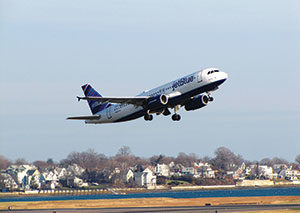
The Somerville Board of Aldermen is redoubling its efforts to gain some relief from the increasing noise levels caused by over-flights to and from Logan International Airport.
By Erin Wade
The annual number of complaints over air traffic noise in Somerville is over 10 times higher today than it was three years ago, according to Massport data, following the transition to GPS-based flight paths from Runway 33 Left at Logan International Airport in mid-2013.
From June 1, 2016, to May 31, 2017 – the most recent date for which data was available on the Massport website – Somerville residents filed a total of 2,428 complaints with Massport. During the same time period in 2013 and 2014, only 202 complaints were filed.
And the city’s representatives are taking steps to address this uptick in constituent complaints.
“I am just beyond thrilled that President [of the Board William] White is working with me on this, and we have the total support of the Board of Aldermen,” Alderman-at-Large Mary Jo Rossetti said in a phone interview, noting that U.S. Rep. Mike Capuano also included, in an FAA reauthorization bill, language aimed at helping to prevent air traffic noise over Somerville.
During remarks at the July 13 Board of Aldermen meeting, White railed against hardships for Somerville residents coping with air traffic noise.
“For the people who live under this, who can’t get five hours of sleep a night for half of a month, it’s pretty bad,” White said.
White mentioned in his remarks that he had noticed a recent increase in the number of flights taking off from Logan’s Runway 33 Left, which sends flights directly over Somerville, late at night and early in the morning.
“I literally spent, I don’t know, 20 hours going to the runway monitor and actually monitoring all of the flights during the evening, and then in the morning, for the month of May and June,” White said, noting that this was the reason he and other members of the Board were sending a letter of complaint to the Federal Aviation Administration.
White’s letter, which he was authorized to send at the July 13 meeting, notes that Runway 33 Left was used for both a late-night and early morning departure 13 times during the month of May, meaning “there was less than a six-hour break from the last evening flight until the next morning flight for those residents impacted by 33L departures.”
In his letter, White says that the pattern of late-night and early-morning flights from Runway 33 Left continued in the month of June, with 14 departures leaving less than six hours between the final flight of the evening and the first flight of the morning, and called the pattern “a deviation from the traditional assignment of runway usage during the months of May and June.”
Rossetti said she has heard from constituents who are directly impacted by the brief break in flights at night.
“There are many families with young children who reach out to me to tell me that they’re beyond frustrated that their children’s sleep is being disrupted because of the airplane noise,” Rossetti said over the phone.
But Wig Zamore, Somerville’s Massport Community Advisory Committee and Logan representative, said at the Board of Aldermen meeting on July 13 that Somerville saw more total air traffic noise pre-2013 and that alterations to flight paths in mid-2013 had reduced the total amount of noise over the city.
“The noise was more in the east and the north and less in the west and the north, but there was more total noise, there was louder noise because it was lower to the ground and it also was a more intense environmental justice community that got that noise,” Zamore said.
Zamore said the FAA and Massport have hired John Hansman, director of MIT’s International Center for Air Transportation, to implement a number of small changes to reduce the noise airplanes produce when they fly over Somerville.
Zamore also noted that Logan has just two long runways — 33 Left and 4 Right — that large, international jets can use. Since Logan is doubling its capacity at Terminal E, which services international flights, Zamore says nighttime air traffic on Runway 33 Left will continue to increase.
When White said his observations of airplane takeoffs suggest that flights using Runway 33 Left late at night aren’t just international flights, Zamore suggested that White revise his letter to the FAA to request a yearlong study of takeoffs from the runway.
Capuano’s language in the FAA reauthorization bill would also address these late-night flight patterns. In a newsletter to constituents, Capuano said the amendments he added to the bill required “the FAA to consider ‘dispersing’ flights to address noise concerns if the community and airport request it.”
A second addition Capuano made to the bill would require the FAA to review its noise exposure standards, which were set in the 1970s, because according to Capuano’s newsletter, “The science behind noise exposure has no doubt gotten more sophisticated since then, and the FAA should at least consider whether the limit should be updated.”
Director of Communications for Capuano Alison Mills said in an email that the FAA reauthorization bill, with Capuano’s amendments attached, has passed out of the House Transportation Committee and is awaiting floor action in the House of Representatives.












Reader Comments